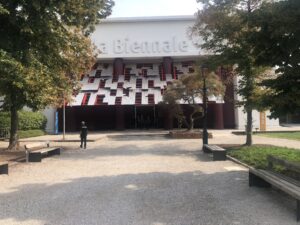Every city should have an exhibition representing main countries in the world. Can be an Expo like that normally done in one different place every year, or a more specialised one like Biennale in Venice. We talk about globalisation, but we don’t give concrete tools to people to document theirselves on the planet life in 200 different cultures and States, which could give a real sense of diversity and complexity of human societies of our world.
The Biennale of Architecture, established in the 30ties, is an important mirror, into which you can see most important communities expression, being architecture a nice synthesis of cultural, social, technical progress of a State. Every two years this exhibition acts as a thermometer of global and local development of social environment. So I want to transfer to readers my impressions of 2023 edition. I am used to start in my visit from the countries of beautiful design, Scandinavian ones, so I visited Finland as the first one. The general theme of this edition has been “The laboratory of future”, and here we find immediately a divice already existing in 500000 summer houses of that beautiful country: a toilet not using water, in a green and recycling perspective.
This toilet (hussi) made from recycled and transformed plastic waste, produces directly a compost that can be used as a fertiliser in gardens, as the present trees and flowers can demonstrate. It indicates in a very simple way a trend to the future to sparing water contribution, reducing also the investments in water treating plants, so expensive in the cities and frequently bad performing. Sweden pavilion presents on the basis of green approach, the artistic and decorative creations of Sami people, in their environment, with houses and camps builded only by wood and skins of reindeers, recreating a natural space were immediately you can absorb the tradition of this old people distributed from Sweden to Russia over the Polar Circle.
The USA dedicates their participation to recycling polymers constituting plastics products, with a surprising collection of artistic installation re-utilising plstic waste through forms and colours for new furniture ideas or industrial application. A realistic and innovative approach giving hope to give a new sense to the daily plastic invasion. Japan returns to a more human involvement, making its artisans working with people visiting pavilion to produce artistic objects, printing cards, decorating ceramics, in a a joy atmosphere very appreciated by anyone. South Korea questions directly to people, through technological tools, if they are of GDP religion or more focused on quality of life, obtaining obvious answers from this type of visitors. Germany has a very original approach: the dismantling of Biennale creates a dramatic impact on logistic of Venice, for the amount and variety of materials to be discharged or recycled. Germany offered its pavilion as a warehouse for all these materials to facilitate their processing after the exhibition closing. France distinguish itself reproducing a small theatre where anyone can participate with some contribution in singing or making music or saying something. Czech Republic animates a debate on workers exploiting, loyal to its social Hussite culture. UK leaves all the space to presentations of ideas and products of the many different cultures coexisting in the country.
Hungary is the only one presenting in traditional way a big architectural project realised in Budapest, the Etnographic Museum, in a context of restructuring all the big Liset Park where other Art Institute are present. And Italy? In the most historical and large pavilion Italy opens to African cultures and projects of urbanisation and new architectures in civil building for social events and arts: a generous contribution to know Africa, which can be considered a correct interpretation of the 2023 theme of Biennale, about the future.




